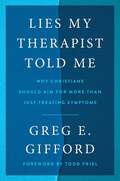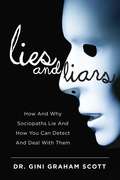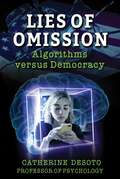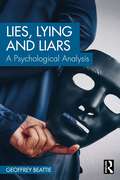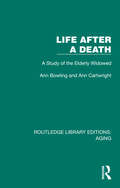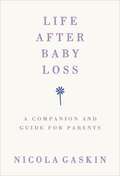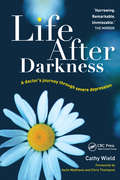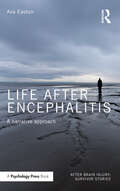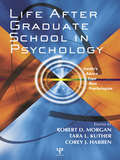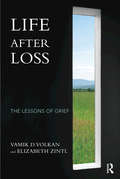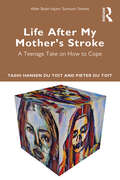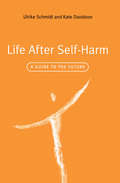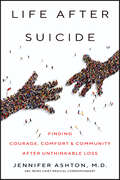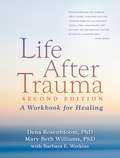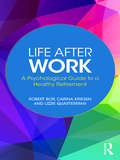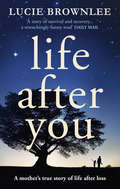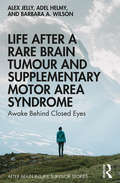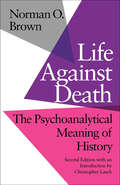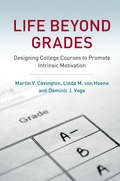- Table View
- List View
Lies My Therapist Told Me: Why Christians Should Aim for More Than Just Treating Symptoms
by Greg E. GiffordFrom beloved Christian counselor, professor, and podcaster Greg Gifford comes a bold critique of the mental health establishment. Therapy can backfire and fail, but Christ offers more. Too many people are caught in a vicious cycle of visiting every doctor, psychiatrist, psychologist, and therapist in their area only to find frustrating labels and numbing medications at the end of each path. Rather than eradicating anxiety in the same way vaccines conquered smallpox, the mental health establishment has seen the number of diagnoses and prescriptions skyrocket on its watch.How did we get here? And does Christianity have any answers for this mental health crisis?In Lies My Therapist Told Me, Dr. Greg Gifford delivers the definitive Christian critique of secular psychiatry and psychology. He shows how mental health culture spreads beliefs that misinform our understanding of ourselves and our issues, and he debunks popular myths such as:We feel and act the way we do because the body keeps the scores of traumaAddiction is a diseaseIf you improve your brain health, your mind will followMedications can heal your soulEvery abnormal or sinful behavior is caused by a mental disorderThese ideas, though common, are ultimately unhelpful because they are based on unbiblical assumptions. Gifford brings clarity where secular therapy has created confusion, and offers hope even for those struggling with the hard cases. Through deep research, biblical teaching, and the inspiring stories of real counselees, he shows why we can’t blame the past —or even a diagnosis— for our bad behavior, and why our society’s growing unhappiness is not primarily a medical issue.With a foreword by Todd Friel of Wretched Radio, this book is a must-read for counselors and counselees alike. You can read all the mental health research in the world, but you still won’t learn God’s answers for winning the battles in your mind. Lies My Therapist Told Me is a powerful, cutting-edge argument that the supernatural wisdom of the Bible is truly enough for every need.
Lies and Liars: How and Why Sociopaths Lie and How You Can Detect and Deal with Them
by Gini Graham ScottApproximately 12 million Americans, or one in twenty-five, are sociopaths. But what does this statistic mean? What exactly is a sociopath? What do they do to be labeled as such? And how many people are affected by them? While everyday lying has become acceptable and even socially necessary, it is often difficult to discover when someone is manipulating you through lies or other actions. Since a sociopath has no conscience, he or she feels no remorse about piling lie on top of lie until, eventually, the façade comes crashing down and he or she is exposed.When Dr. Scott was warned about a film producer she had hired, she confronted the woman, only to be fed explanations and excuses. Eventually, Scott found that she had been the victim of this sociopath for five years, along with many others. In this book, she delves into medical research on sociopaths as well as interviews with sociopaths and victims alike to provide a comprehensive picture of this mental disorder. Lies and Liars also includes information about:The types of lies told by sociopaths in different situationsThe relationships between sociopaths and victimsRecognizing when someone is lyingHow to deal with a suspected or discovered sociopathic liarThe odds are very high that you know a sociopath already, so figure out what signs to look for to prevent yourself or your loved ones being manipulated or harmed.
Lies of Omission: Algorithms versus Democracy
by Catherine DeSotoA lie of omission—withholding needed information to correct a false belief. There is a sharp and more hostile divide emerging in the United States. The shift is documented by various polls, and the speed of the change is alarming. There are certainly contributing factors, but one factor is unique to the contemporary era: receiving the majority of our information via social media experiences. Media algorithms, and to some extent overt censorship, serve users curated content that is unlike what their neighbors receive.Lies of Omission brings together various perspectives on the causes and effects of the divided information streams. Psychology and neuroscience, combined with some historical jurisprudence, are woven together to spell out the dangers of the modern social media experience. Importantly, the human response can be understood as rooted in our psychology and neurochemistry. In part two of the book, eight hot button issues that have provoked deep divisions among American citizens are presented as well-researched, opposing-view chapters with a goal to lay bare the extent of the disinformation gap that we are living in. With the rise of ephemeral smart media, and the associated displacement of the permanently printed word, it is rare to have a clear idea of what persons who do not share our opinions actually believe, or why.The decimation of communal information sources is nearly complete. What can one do? One concrete step is to turn some of your attention away from curated, impermanent news and read a book. Read this book. Dr. Catherine DeSoto spells out why it is worth our time to be informed regarding the issues we care about: something your phone&’s curated media will never do for you. Open your mind to the quaint idea that one is not informed unless one understands the opposing view. Surprising all-new research regarding the political divide and the pandemic is included. Together with over 150 references, this book will be the definitive source documenting the effects of the media algorithm revolution.
Lies, Lying and Liars: A Psychological Analysis
by Geoffrey BeattieLies, Lying and Liars: A Psychological Analysis delves into the psychology of lies, exploring the processes of lying and its far-reaching consequences.The author’s unique approach considers the ways in which lying sculpts our realities when used by public figures such as politicians, as well as how lying is woven into our everyday life. This book dissects lies in natural social contexts, from the innocent childhood fibs to the more nefarious fabrications of con artists, cheats, and adulterers. Drawing from a rich tapestry of psychology and sociobiology, as well as research and literature from philosophy and the social sciences, this book discusses the role of lying and liars in day-to-day life. It offers profound insights into the strategies of deceit, the presence or absence of remorse, emotion and rationalisations, pathological liars, the development of lying, its connection to narcissism, the functional utility of lies, and lie detection. Lies, the book argues, are a part of the social structures inherent in everyday social life, and there is a need to explore their psychological significance in a range of natural, everyday contexts.Written in Beattie’s unique and engaging style by using elements of personal narrative and self-reflection, this is a fascinating read for students and scholars of psychology, sociology, and politics, and other disciplines of the behavioural and social sciences, as well as anyone interested in the phenomenon of lying.
Life 101: Everything We Wish We Had Learned about Life in School-- But Didn't
by Peter McwilliamsTips on how to live a happier life
Life After A Death: A Study of the Elderly Widowed (Routledge Library Editions: Aging)
by Ann Cartwright Ann BowlingThe recently widowed experience many complex problems, and an understanding of their needs and the kinds of difficulties they encounter is essential if appropriate services and help are to be mobilized. It is the old who are most likely to be widowed, and they may face this crisis at a time when they may also be adjusting to ill health and increasing infirmity, and to retirement, with its problems of role identification and adaptation to an increase in leisure and a decrease in wealth. Most will have to learn to live alone, or to uproot themselves from their home and adjust to life with relatives. Often, the elderly person will have been involved in caring for their spouse during his or her terminal illness; widowhood will mean that they have lost their main occupation. For some, who are themselves disabled, widowhood may mean that they have lost the person who cared for them, so that there is an immediate crisis as alternative sources of care need to be found. These problems have to be faced in a situation often complicated by the anxiety, loneliness, apathy, and bewilderment of bereavement.Originally published in 1982, Life After A Death presents the results of a study of the experiences and attitudes of over 350 elderly widowed men and women, their general practitioners, and their relatives, friends, and neighbours, and considers the implications of the help the widowed received, or failed to receive, from those to whom it was most likely that they would turn for support. The authors’ identification and description of the emotional and practical day-to-day needs of the widowed, and their recommendations about the potential role of the general practitioner and voluntary and social services, should be considered by all those concerned to alleviate the difficulties of the widowed, and to help them to live a better ‘life after a death’.
Life After Baby Loss: A Companion and Guide for Parents
by Nicola Gaskin**Winner of Author of The Year at The Butterfly (Baby Loss) Awards**For all parents and family managing the emotional battlefield of baby loss.When my baby died my whole world changed forever. I was left full of love, yet deeply heartbroken and faced with the task of living without my most precious longed for treasure. Following a fraught journey of trying to conceive again, two subsequent miscarriages, and an anxiety fuelled pregnancy after loss, I was finally able to welcome my baby girl into the world. This is the book I wish I’d been given – it will help you to not only survive the loss of your baby but to celebrate the life they had, no matter how brief. This is my hard won gift to you.Losing a child is one of the most devastating events you can go through and yet, losing your baby – particularly before they are born – remains a taboo and often misunderstood topic. In this very gentle guide, Nicola Gaskin opens up the conversation around baby loss offering raw, honest and deeply empathetic support to all parents. From coping with the initial shock, finding ways to overcome jealousy and anger, surviving birthdays and Mother’s Day, through to living with everlasting grief and the fresh round of grief and anxiety that comes with parenting after loss, it will help you to navigate through a huge range of intense and complex emotions.Beautifully written and powerfully illustrated, this book will hold your hand through your darkest and lightest moments: read it to know you are not alone and that all your feelings are absolutely valid.
Life After Brain Injury: Survivors' Stories (After Brain Injury: Survivor Stories)
by Barbara A. Wilson Jill Winegardner Fiona AshworthThis is the first book of its kind to include the personal accounts of people who have survived injury to the brain, along with professional therapists' reports of their progress through rehabilitation. The paintings and stories of survivors combine with experts' discussions of the theory and practice of brain injury rehabilitation to illustrate the ups and downs that survivors encounter in their journey from pre-injury status to insult and post-injury rehabilitation. Wilson, Winegardner and Ashworth's focus on the survivors' perspective shows how rehabilitation is an interactive process between people with brain injury, health care staff, and others, and gives the survivors the chance to tell their own stories of life before their injury, the nature of the insult, their early treatment, and subsequent rehabilitation. Presenting practical approaches to help survivors of brain injury achieve functionally relevant and meaningful goals, Life After Brain Injury: Survivors’ Stories will help all those working in rehabilitation understand the principles involved in holistic brain injury rehabilitation and how these principles, combined with theory and models, translate into clinical practice. This book will be of great interest to anyone who wishes to extend their knowledge of the latest theories and practices involved in making life more manageable for people who have suffered damage to the brain. Life After Brain Injury: Survivors’ Stories will also be essential for clinical psychologists, neuropsychologists, and anybody dealing with acquired brain injury whether they be a survivor of a brain injury themselves, a relative, a friend or a carer.
Life After Darkness: A Doctor’s Journey Through Severe Depression
by Cathy WieldLife After Darkness is the remarkable and moving story of a doctor and mother of four who endured seven years of severe depression. Self-harm, attempted suicides and admissions to psychiatric units culminated in her resorting to brain surgery as a final attempt to escape her illness. The story of Cathy Wield covers the horrors of time spent in archaic institutions and the loss of any hope, to a full recovery following surgery. Today she has returned to her career and rediscovered the joys of life and her family. This story is one of hope from an often hidden and stigmatized disease.
Life After Death: Surviving Suicide
by Richard BrockmanAn intertwined tale of a boy&’s world shattered by suicide and a man&’s story rewritten by neuroscience. When Richard Brockman found his mother&’s body, the simple narrative of his childhood ended. Life After Death tells the story of a boy who died and of a man who survived when the boy and the man are one and the same. It tells a very personal—yet tragically common—story of irredeemable loss. It tells the story of story itself. How story forms. How it grows. How it changes. How it can be broken. And finally, how sometimes it can be repaired. Now an expert in genetics, epigenetics, and the biology of attachment, Brockman chronicles his evolution from a child overwhelmed by trauma to a man who has struggled to reclaim his past. He lays bare the core of one who is both victim and healer. By weaving together childhood despair and clinical knowledge, Brockman shows how the shattered pieces of the self—though never the same and not without scars—can sometimes be put back together again.
Life After Encephalitis: A Narrative Approach (After Brain Injury: Survivor Stories)
by Ava EastonEncephalitis is a devastating condition whose impact upon people should not be underestimated. It robs people of abilities most of us take for granted, it leaves people without their loved ones, and even in those families where the person affected survives the person they once knew can be dramatically changed. Life After Encephalitis provides a unique insight into the experiences of those affected by encephalitis, sharing the rich, perceptive, and often powerful, narratives of survivors and family members. It shows how listening to patient and family narratives can help us to understand how they make sense of what has happened to them, and also help professionals better understand and engage with them in practice. The book will also be useful for considering narratives associated with brain injuries from other causes, for example traumatic brain injury. Life After Encephalitis will appeal to a wide range of professionals working in rehabilitation settings, and also to and survivors of encephalitis, their families, and carers.
Life After Graduate School in Psychology: Insider's Advice from New Psychologists
by Tara L. Kuther Robert D. Morgan Corey J. HabbenWith the diverse array of career opportunities for psychologists--ranging from academics and practice, to business and industry--this book offers a wide-ranging career guide for graduate and postdoctoral students, as well as interns and new psychologists, seeking employment opportunities in the field of psychology and beyond.
Life After Lockdown: Resetting Perceptions of Autism
by Ruth PrystashIn this one-of-a-kind collaboration with over 40 well-known professionals and individuals with ASD, this book has wisdom, humor, and a hefty dose of reality for autistic and non-autistic readers. A moment-in-time book whose relevance will last. Discover strategies for thriving as society reopens after the pandemic while exploring the reflections of autistic individuals who are living through its aftermath. <p><p>Perfect for anyone on the autism spectrum—and those who support them—Life After Lockdown: Resetting Perceptions of Autism offers practical and thought-provoking plans for rebuilding social connections, returning to school, handling stress, and navigating a post-COVID world.
Life After Loss: The Lessons of Grief
by Vamik D. VolkanHow we cope with grief and come to terms with the death of a loved one shapes our world. In this comprehensive guide to the mourning process, Dr Volkan, a world-recognised authority on grief, shows how each mourning is as individualised as our fingerprints, encoded with our past history of losses. Anecdotal and compassionate, this is a profoundly moving and informative study of how grief and loss shape all our lives.
Life After My Mother’s Stroke: A Teenage Take on How to Cope (After Brain Injury: Survivor Stories)
by Pieter du Toit Tashi Hansen du ToitTashi Hansen du Toit was 15 years old when her mother, Karen, suffered a severe haemorrhagic stroke which left her with multiple physical and cognitive impairments. This beautifully written and poignant account tells Tashi’s story from the first moments after her mother’s stroke, following her and her family through the experience of her mother’s hospitalisation and rehabilitation. Tashi offers a rare glimpse into the impact of her mother’s stroke on her family and on her life as a teenager as she juggles the stresses and demands of family, school, and friends alongside coping with her mother’s brain injury. As she describes how she is learning to cope with her unresolved grief three years on, she provides hope, perspective, and insight on how to work towards growth and acceptance despite the catastrophe of a parent’s stroke. Presenting the rarely heard adolescent perspective on parental brain injury, Tashi’s moving story also features Karen’s account as she comes to terms with her experience. This authentic book offers great support to others, particularly teenagers, who may be going through a similar experience. It is also valuable reading for those working in brain injury services and the education system, and for any professional or student involved in neurorehabilitation or supporting families of parents with brain injury.
Life After Self-Harm: A Guide to the Future
by Ulrike Schmidt Kate DavidsonIn many countries there has been an alarming increase in rates of suicide and self-harm, yet the stigma attached to these difficulties often leads to sub-optimal care. Life After Self-Harm: A Guide to the Future is written for individuals who have deliberately harmed themselves. Developed through a major research project the contents of the manual have been informed and shaped by many users and expert professionals. Illustrated with multiple case-histories, it teaches users important skills: for understanding and evaluating self-harm for keeping safe in crisis for dealing with seemingly insolvable problems for developing coping strategies for re-connecting with life. Health workers who regularly come into contact with individuals who have self-harmed will find the wealth of practical advice in this book extremely valuable for recommendation to patients either as a self-help book, or in the context of brief therapy.
Life After Suicide: Finding Courage, Comfort & Community After Unthinkable Loss
by Jennifer AshtonFrom the chief medical correspondent of ABC News, an eloquent, heartbreaking, yet hopeful memoir of surviving the suicide of a loved one, examining this dangerous epidemic and offering first-hand knowledge and advice to help family and friends find peace.Jennifer Ashton, M.D., has witnessed firsthand the impact of a loved one’s suicide. When her ex-husband killed himself soon after their divorce, her world—and that of her children—was shattered. Though she held a very public position with one of the world’s largest media companies, she was hesitant to speak about the personal trauma that she and her family experienced following his death. A woman who addresses the public regularly on intimate health topics, she was uncertain of revealing her devastating loss—the most painful thing she’d ever experienced. But with the high-profile suicides of Kate Spade and Anthony Bourdain, Dr. Ashton recognized the importance of talking about her experience and the power of giving voice to her grief. She shared her story with her Good Morning America family on air—an honest, heartbreaking revelation that provided comfort and solace to others, like her and her family, who have been left behind. In Life After Suicide, she opens up completely for the first time, hoping that her experience and words can inspire those faced with the unthinkable to persevere. Part memoir and part comforting guide that incorporates the latest insights from researchers and health professionals, Life After Suicide is both a call to arms against this dangerous, devastating epidemic, and an affecting story of personal grief and loss. In addition, Dr. Ashton includes stories from others who have survived the death of a loved one by their own hand, showing how they survived the unthinkable and demonstrating the vital roles that conversation and community play in recovering from the suicide of a loved one. The end result is a raw and revealing exploration of a subject that’s been taboo for far too long, providing support, information, and comfort for those attempting to make sense of their loss and find a way to heal.
Life After Trauma: A Workbook for Healing, 2nd Edition
by Dena Rosenbloom Mary Beth Williams Barbara E. WatkinsTrauma can turn your world upside down--afterward, nothing may look safe or familiar. This compassionate workbook has already helped tens of thousands of trauma survivors start rebuilding their lives. Full of practical strategies for coping and self-care, the book guides you toward reclaiming a solid sense of safety, self-worth, trust, and control, as well as the capacity to be close to others. The focus is on finding the way forward in your life today, no matter what has happened in the past. The updated second edition has a new section on managing emotions through mindfulness and an appendix on easing the stress of health care visits. Dozens of step-by-step questionnaires and exercises are included; you can download and print additional copies of these tools for repeated use.
Life After Work: A Psychological Guide to a Healthy Retirement
by Robert Bor Carina Eriksen Lizzie QuartermanRetirement is a comma in our lives, not a full stop. Life After Work looks at the psychological, emotional and wellbeing issues that surround this complex and important transition in life. This book suggests that retirement is a life stage over which we may have greater control than previously thought; it no longer has to be the case that retirement is a terminal point, a time where you became sedentary and inactive. Retirement is on one level a private, individual matter that affects one’s sense of self and purpose, physical and mental processes, as well as financial security or provision. On another level, retirement has an impact on relationships with loved ones, family and friends, as well as colleagues. It can strengthen or disrupt bonds, leading to new bonds being formed or to withdrawal. This book is written by successful authors and psychologists Robert Bor, Carina Eriksen and Lizzie Quarterman, each with many years’ experience of helping people cope with life stage changes and prepare for retirement. It contains illustrative case studies throughout, from which valuable lessons can be learned, and draws on the very latest psychological research and techniques to provide a blueprint for planning and living a wonderful retirement or life post-work. Planning for your future is crucial in enabling you to maximise the opportunities available. Following the book’s blueprint will help you prepare for this phase in your life, and the sooner you start the better. Life After Work will be of great interest to readers of all ages seeking guidance on retirement and will also appeal to psychologists of life stage changes.
Life After You
by Lucie Brownlee‘He crashed on to the pillow next to me, heavy as a felled oak. I slapped His face and told Him to wake up. Our daughter, B, appeared in the doorway, woken up by the screaming – I must have been screaming but I don’t remember – and she was crying and peering in. I told her the ultimate adult lie; that everything was all right.’Sudden death is rude. It just wanders in and takes your husband without any warning; it doesn’t even have the decency to knock. At the impossibly young age of 37, as they were making love one night, Lucie Brownlee’s beloved husband Mark dropped dead. As Lucie tried to make sense of her new life – the one she never thought she would be living – she turned to writing to express her grief. Life After You is the stunning, irreverent and heartbreakingly honest result.
Life After a Rare Brain Tumour and Supplementary Motor Area Syndrome: Awake Behind Closed Eyes (After Brain Injury: Survivor Stories)
by Barbara A. Wilson Alex Jelly Adel HelmyThis book offers a personal insight into the experience of Alex Jelly, a professional fundraiser who developed a rare brain tumour, a papillary meningioma, which was successfully removed. She was left with Supplementary Motor Area Syndrome and associated problems including motor and speech impairments and a temporary psychosis. Discussing Alex’s struggles and triumphs throughout her rehabilitation, this book offers an honest account of her journey from diagnosis to recovery. Part I introduces Alex’s early life and employment, symptom onset and diagnosis, treatment and rehabilitation. Part II presents her neurosurgeon, Adel Helmy, and a clinical neuropsychologist, Barbara A. Wilson. Adel provides a medical context by explaining Alex’s successful surgery and her post-operative experience. Finally, Barbara concludes with a comprehensive view of Alex’s recovery and gives a voice to the therapists and psychologists who worked with Alex throughout her in and outpatient rehabilitation journey. This book provides support, understanding and hope for patients who have suffered a brain tumour, and their families. It is valuable reading for any professional involved in neurorehabilitation, studemts of clinical neuropsychology and those touched by brain injury.
Life After: A testament to human resilence. 60 Australians on coming to terms with grief
by Evonne MaddenHaving to deal with the loss of loved ones is something that unites us all. Yet we rarely even talk about it.Life After shares the raw, intimate and inspiring stories of how more than 60 ordinary and well-known Australians have recovered from heart-breaking loss and have rebounded to live fuller lives than they once thought possible.Full of optimism and spirit, this book features famous people who have lost loved ones, people whose loved ones were famous, the bereaved behind our biggest news stories and a gamut of experiences from every walk of life in Australia.
Life Against Death: The Psychoanalytical Meaning of History
by Norman O. BrownA shocking and extreme interpretation of culture, history, and the father of psychoanalysis. In Life Against Death: The Psychoanalytical Meaning of History, social philosopher Norman O. Brown radically analyzes and critiques the work of Sigmund Freud. Brown attempts to define a non-repressive civilization, draws parallels between psychoanalysis and the theology of Martin Luther, and also examines the revolutionary themes present in western religious thought, such as ideas found in the work of William Blake and Jakob Böhme.&“Life Against Death cannot fail to shock, if it is taken personally; for it is a book which does not aim at eventual reconciliation with the views of common sense. The highest praise one can give to Brown&’s book is that, apart from its all-important attempt to penetrate and further the insights of Freud, it is the first major attempt to formulate an eschatology of immanence in the seventy years since Nietzsche.&” —Susan Sontag&“One of the most interesting and valuable works of our time. Brown&’s contribution to moral thought . . . cannot be overestimated. His book is far-ranging, thoroughgoing, extreme, and shocking. It gives the best interpretation of Freud I know.&” —Lionel Trilling
Life B: Overcoming Double Depression
by Bethanne PatrickA bracing and fresh look at a lifelong struggle with depression and mental illnessPlagued by depression her entire life, it wasn&’t until her early fifties that writer and book critic Bethanne Patrick, advocating for her own care, received a medical diagnosis that would set her on the path to wellness and stability.Recognizing the intergenerational effects of trauma and mental health struggles, Patrick unearths the stories of her past in order to forge a better future for herself and her two daughters, dismantling the stigmas surrounding mental health challenges that can plague families into silence and resignation. Life B is an intimate portrait we haven&’t yet seen—of a lifelong struggle with depression, of midlife diagnosis and newly found strength. Most important, it&’s a life-affirming blueprint of how to accept and transcend the limitations of mental illness.
Life Beyond Grades: Designing College Courses to Promote Intrinsic Motivation
by Covington Martin V. Von Hoene Linda M. Voge Dominic J.This book raises the question of whether or not educators can promote intrinsic motivation among college students when they seem overwhelmingly focused on grades. Indeed, can there be life beyond grades? The answer is 'Yes'. A love of learning can coexist, even thrive, in the face of competing pressures from grades. Drawing on recent, ground-breaking classroom research, the authors articulate a new understanding of the causes of the stalemate between intrinsic and external motivation, so that a reconciliation between them can be achieved. Then the authors apply a powerful set of motivational and pedagogical principles to lay out a step-by-step blueprint for designing and teaching college courses that promote intrinsic motivation as a primary educational goal in its own right, above and beyond knowledge and skill acquisition. This practical blueprint draws on authentic case study examples from a variety of subject-matter disciplines.
